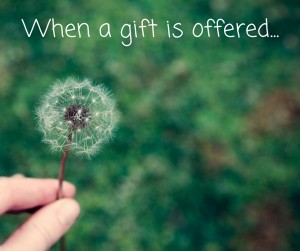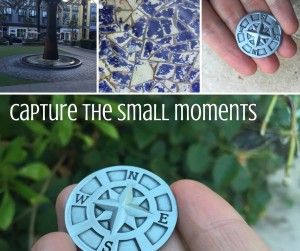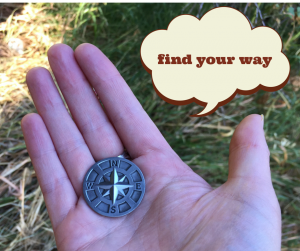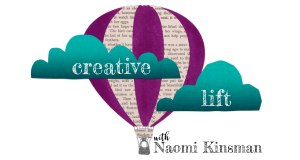by Naomi | Feb 2, 2016 | Creative Life

Have you ever given a gift, only to have it refused? There’s that horrible iron-door-slamming-shut-between-you feeling, the kind that makes you back away. Offering a gift is an invitation. You say to someone, “Will you accept this love I’d like to share?” When the person refuses, it’s not only the gift that’s shoved aside, but you.
And yet, accepting gifts isn’t always easy. Why?
Offering a gift is a vulnerable act. And accepting a gift may be even more vulnerable.
When you offer a gift, you’ve had time to think, prepare and plan. When you accept a gift, particularly a meaningful one, you often face the element of surprise. Unexpected emotions can leap up and catch you off guard. In most cases, to accept a gift you must acknowledge the fact that you can’t do everything on your own. All of these things … the emotions, the sharp pain of vulnerability, the questions, the fears … rise up like a tsunami wave as the gift is held out in open hands. The question is: Will you say yes?
I’ve been thinking a lot about gifts this week. I want to be the courageous kind of person who can accept gifts with open arms. Too often, I struggle.
We’re raising funds right now to support the work of Society of Young Inklings, and specifically for our new partnership with Boys and Girls Club of the Peninsula. As part of this campaign, we’re putting on a show and silent auction benefit on Friday. Our goal is to extend our reach and, as in all of our programs, to offer young writers support as they discover their unique voices. Through this fundraising process, I’ve been given a stream of extraordinary gifts.
- Our instructional staff has given the gift of their time. They’ve volunteered to collaborate on the script and spent hours rehearsing. Team members have offered leadership: directing the show, shaping and revising the script, costume and prop design, and much more.
- Our board has offered gifts of financial support and spread the word about our campaign and event near and far.
- Our development team has expertly helped me more clearly see the tangible impact of our work and also uncovered ways to continue to assess, refine and grow our programs.
- Our community has stepped up to provide donations for our silent auction and financial gifts in support of our work.
These gifts, overwhelming as they are, are only a small part of the flood of support we’ve experienced at Society of Young Inklings. And then, beyond SYI, daily gifts of support have been showing up in all corners of my life.
- In pour-over coffee hand-delivered to me at my desk by my husband while I’m struggling to meet a writing deadline.
- In friends spreading the word about the release of the Glimmer Girls books, a series of fiction on which I collaborated with singer, Natalie Grant.
- In friends reaching out to tell me they’re thinking about me.
- In the just-right book showing up at the just-right time.
And so much more.
Anyone who knows me very well knows that I’ve been working hard for quite some time now, reaching for a very big dream. And now, having so much support show up as I’m taking final steps toward a peak on the journey … it feels like a crowd of my friends and loved ones and colleagues have gathered on the sides of the path to cheer me on. To tell me they know I can make it to the end of this climb, even if I’m wondering about that, myself.
Honestly, these gifts take my breath away. Each time one is offered, I struggle to accept it.
But I’m practicing throwing my arms wide. I’m practicing saying … shouting … yes! I’m learning that gifts fill us with energy we didn’t think we had, an overflowing kind of energy that makes us ready to turn around and pass on gifts elsewhere. Gifts rejuvenate us and create momentum. Someone gives to us and that gift multiplies inside us. Now, we have the power to reciprocate and also to give with wider reach. On and on, the gifts ripple, growing in strength and possibility … because we said yes.
Many of you reading this post are part of that cheering crowd of supporters. To you, I want to say … I need to say … thank you. Your gifts mean more to me than I am able to put into words. Your gifts are making an impact far beyond what any of us can see today.
And so, what about you? What gift can you say yes to today? I’d love to hear your thoughts in the comment section below. Or, you can give me the gift of discussing this further with me on Twitter or on Facebook. I will gladly accept.
With much love and gratitude.
—
Psst… Do you know about Naomi’s Tinder Box: a weekly collection of curated resources, inspiration and encouragement? Keep your creative spark ablaze … sign up for exclusive access here.
by Naomi | Feb 1, 2016 | Tools & Apps
Naomi’s Playlist is an eclectic collection of tools that help me approach my work as play. My hope is that they’ll do the same for you!

Object: Taking note of the small joyful moments in each day.
What Didn’t Work: Rushing through every day. Feeling like I should be paying attention or keeping track, somehow, but not quite succeeding. Making it to the end of the day and wondering where all the small moments had gone.
My Aha! Moment: On vacation in December, I was poking around with my Day One journaling app, which simplifies keeping a virtual journal. But truth be told, I like writing on paper more than I like typing on my phone. My thoughts seem to flow more freely from hand to paper. Yet, I’m conflicted about this because a digital tool can add images and is more likely to be with me all the time. Some days I have time to thoughtfully sit down with paper and pen, and other times, I just don’t.
So, my aha! moment came in two parts.
First, I gave myself permission to use more than one tool. A paper journal? Permission granted. Day One, because I was already using it? Also allowed. And exploring a new tool? Exploring was allowed, too.
Second, while exploring, I stumbled across HeyDay, a journaling app for the iPhone that takes your pictures and automatically turns them into collages. The app even pulls past photos from your stream and captures past memories. It’s like waving a magic wand and presto–A visual journal!
How I Play:
- Having HeyDay on my phone gives me a reason to stop and take photos at random times of the day. They doesn’t have to be a special photo-worthy moments. The point is remembering the small things. Who was I with today? Where did we go? What did we do? The more photos the better.
- HeyDay can use your GPS to keep track of where you go through your day. I like this feature because it helps me track beyond my pictures. Also, when I’m in an unusual location that I’ve been to before, the app prompts me to check out memories from that place in the past.
- Sometimes I caption my photos and other times I let the photos do all the work. Either way, I’ve paid the moment specific attention. No longer is life a blurry flow of moments I haven’t noticed. Little memories are captured in my phone and in my mental slideshow, too.
Player’s Notes:
- Using the GPS feature can burn up battery, so if you have battery difficulty with your phone, I’d turn this feature off. Or, be ready to charge your phone a little more often.
- I worried about security at first. I didn’t want to be sharing photos I hadn’t meant to share. From all I’ve read, everything is kept private … as private as something stored on an internet server can be. If you’re concerned about security, read up on the FAQ’s.
- You can delete images if you have pictures you take on your phone for other purposes (receipts, etc) that aren’t memory-worthy.
Take it to the Next Level:
- I realized after a few weeks that I only had pictures of everyone else. So, even if you’re camera shy, don’t be afraid to take selfies. That way, you’re present in the collages along with your family and friends.
- HeyDay allows you to add events in the past, so if you want, you can import old pictures and create older memories, too.
by Naomi | Jan 26, 2016 | Creative Life

When I look at a finished artwork, I tend to assume the artist saw the work that way (polished, complete, refined) in their mind ahead of time. The longer I’m a writer, and the more I explore art-making of all kinds, the more deeply I understand the untruth –and unhelpfulness – of this assumption.
Every book I’ve ever written has surprised me. Every book has changed through the process of drafting and revising. And not just little changes. Huge, structural, 180 degree kinds of changes.
What if, instead of waiting until I have a clear vision, I started making art right from where I am today?
A couple weeks ago, I attended a mixed media art journaling class. To start, we laid a foundation of gesso, which is a thick white paint. Then, we wrote in the gesso with a skewer, just free-form thoughts. Then, we used a hair dryer to dry the layer. At this point, unless you looked closely, you couldn’t see a thing. Next, we chose three colors and lightly rolled a paint roller across all three paint dabs. Then, we rolled the colors onto the page in no particular pattern. Again, we dried the layer. And on and on it went, blindly for the most part. We built on the colors and patterns that showed up on the page, and an artwork started to emerge.
As I worked, I thought about improv. At Society of Young Inklings, we use an improv based approach called Writerly Play to help writers get out of their heads and into their natural, spontaneous thinking. The reason we often don’t know what to write, or think we don’t have ideas, is that we’re searching for a finished idea, one we can see fully from the outset.
Despite the fact that I teach Writerly Play all the time – I literally wrote the book on it – I forget in my own work, whether I’m writing or painting or playing guitar, that art is made in layers. I try to see the work ahead of time. I don’t allow myself to try a new art form because I look at finished examples and have no idea how to get from novice to artist. But if art is made in layers, it’s okay for me to be a novice. The first layer doesn’t even have to be visible.
Here’s how I’m going to try building my work in layers.
- I’ll start by playing with supplies. Paint, words, instruments, a camera (via my phone). I’ll explore possibilities until something catches my fancy.
- When something does catch my fancy, I’ll turn my attention to that idea and add a layer.
- After allowing the layer to settle (or dry, depending on my medium) I’ll add another layer. And another.
- I’ll keep going until my artwork is ready to show to someone else, to gain outside feedback.
- Then, I will return and keep working. Some layers will cover up ideas, some will add new ideas, but even the imprint of past work will be part of what is ultimately created.
- And at some point, I’ll pronounce the work finished.
Doesn’t that sound like an interesting experiment? I think this process can work whether the artwork is a song or a collage or a book. Following these steps will cause me to start earlier, work more intuitively, and come up with work that has richness and depth.
I can’t wait to try it. Anyone with me? If you are, let’s chat about what we discover. Share below, or on social media, wherever you want to engage. I’m @naomikinsman, and Naomi Kinsman on Facebook.
by Naomi | Dec 7, 2015 | Creative Life

A round peg shoving myself into a square hole. Often, I feel that way. How about you?
So much helpful advice is flying around out there. Everyone, from your plumber to your online business coach, agrees that to be relevant, you need to provide strategies and resources. We tune in, and if you’re like me, you start hopping from one thing to the next. Ooh, you think, this blog post will help me solve my organization problem … oh, and ooh! This podcast will teach me to be fun and catch followers on Instagram … oh, and wow! This online course will teach me to slow down and pay attention to what’s important … and on and on it goes.
I wonder: When was the last time you listened to your OWN advice?
I’ve been struggling with a paradox for the last year or so. I long to help people tap into their creativity by encouraging them to play more, to strive less. And yet, I dread becoming another noisy distraction. I want to amplify YOUR voice, not drown it out with mine. These clashing desires have caused me to fuss about behind the scenes, trying to figure out what to say, what not to say, when to share and when to stay silent.
Recently, I pulled together a group of writer and illustrator friends for a test-run of a marketing mastermind. We called it “marketing” but honestly, I was focused on a deeper issue that I’ve wrangled mentally for as long as I can remember. Let’s call it “life strategy for creatives.” Or, as I think about it: living as an artist.
TIME OUT for a moment. When I use the word “creative” or “artist,” I don’t mean only those people who have paint under their fingernails. I mean anyone who allows creativity to take the lead in their lives, be they stay-at-home parents, entrepreneurs, coffee roasters, chefs, musicians, master gardeners, strategists … you get the idea. If your primary role takes creative thinking and a commitment to your passion, in my book, you’re living as an artist.
TIME IN. Maybe you heard the well-meaning advice sometime along the way too: You can’t make a living doing that! My response was: I’ll have to, because that’s what I’m made to do. Faced with two options–finding a way to live as an artist or starving–I decided to tackle the life strategy issue. Growth happened in small increments, and I still faced huge bumps in the road. I had no idea that I had actually developed an expertise.
So, at our test-run meeting, I looked around the table at my friends, all of who have their own unique processes and none of whom would fit into a square hole. All of them are on their journeys, and none need “fixing,” yet they all desire solutions, too. Like me, they want to live as artists. And that’s when I realized … All that fussing about keeping out of the way was also keeping me from helping. I had a treasure hoard of gifts that I wasn’t sharing.
Hoarding is definitely not my style. So, here’s what I’ve decided.
- I’m going to stop fussing and start sharing.
- I’m going to trust you to make your own choices about when my voice is helpful and when you need to tune me out to make room for your own voice.
- I’m going to allow myself room to be on the journey, too. Sometimes I’ll have practical advice and other times, I may only have a question I’m starting to explore.
- I’m going to believe that showing up authentically, wherever that happens to be, is enough.
If it’s true for me, I bet it’s true for a lot of you, too. What are you fussing over or hoarding? You don’t have to package it up perfectly. Find a way to share, and trust us to approach your ideas with our own creativity.
by Naomi | Jul 3, 2015 | Tools & Apps
 Object:
Object: Setting realistic expectations for my drive time, and avoiding traffic whenever possible. Also, making my drive-time productive thinking or learning time rather than stressed-out finding-my-way time.
What Didn’t Work: Relying on my favorite back-road route only to find that today that route was clogged with construction traffic. Planning to be to a client in half an hour, only to find that today, an accident had caused a twenty minute delay. Spending my whole drive stressed out and blindly trying other routes instead of being able to relax and spend the time thinking about projects or learning from podcasts or escaping into a story audiobook-style.
My Aha! Moment: I have a strong internal compass, so it took me a long time to give in and let Waze take the lead. But, after enough frustration, and a few unexpected late arrivals for clients, I decided to rely on Waze and its ability to calculate drive-time in real-time. Now, I can text my clients and let them know if the drive may take longer than planned.
- I use a suction cup mount for my phone in my car, so I can see Waze safely as I drive.
- I’ve made it a habit to start up Waze whenever I’m on my way somewhere and time is an issue. I don’t navigate on errands or other more meandering trips, but my husband hopes that my habit will evolve. He uses Waze for nearly every trip we take out of the neighborhood.
- I email or text myself the address of new places I’m headed, so I can easily paste the location into the Waze search. That said, the search function on the app is powerful, and public places are usually simple to locate inside the app itself.
- As long as traffic seems normal, I turn off the app about ten minutes from home. I don’t need all the last turn-by-turn instructions, and that way I can listen to my audiobook or podcast in peace.
Take it to the Next Level:
- I’m trying out TripLog, too, to track business mileage. Since I start up Waze for each drive, it’s just one more step to also start TripLog. Maybe TripLog will make the playlist sometime soon.






